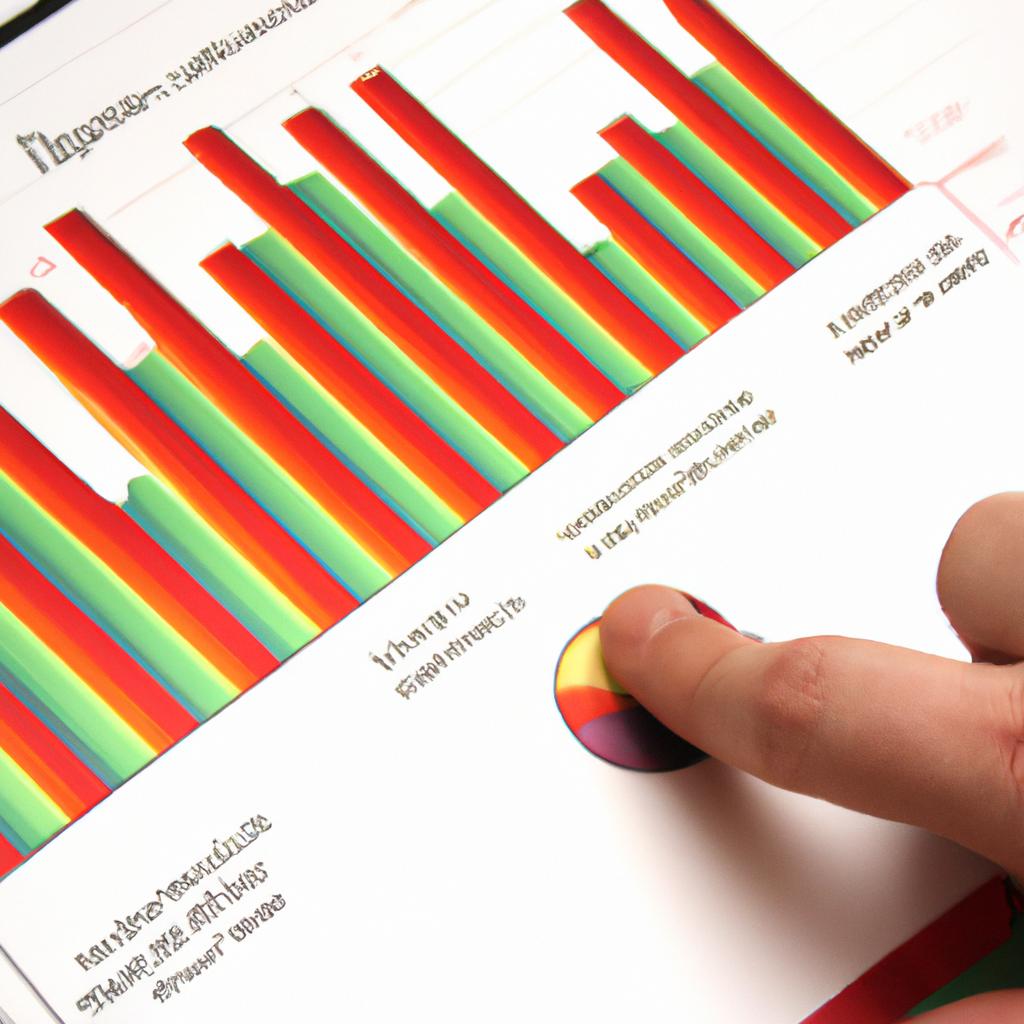Email Marketing: Boost your Online Marketing & Advertising Strategy

Email marketing has emerged as a crucial tool for businesses seeking to enhance their online marketing and advertising strategies. This article aims to explore the significance of incorporating email marketing into an organization’s overall digital marketing efforts. By analyzing a hypothetical case study, we will delve into the various benefits that can be derived from leveraging this powerful technique.
In today’s hyperconnected world, consumers are inundated with countless advertisements across multiple platforms. In such a competitive landscape, it is imperative for businesses to adopt effective strategies that captivate their target audience and drive conversions. One notable example illustrating the potential of email marketing involves a fictional e-commerce company called “Fashionista.” By meticulously crafting personalized emails tailored to individual customer preferences, Fashionista witnessed a significant increase in both website traffic and sales revenue. Through targeted messaging and strategic timing, they were able to foster strong brand loyalty among their customers and establish themselves as a trusted source in the fashion industry.
Segmenting your email list for better targeting
One of the most effective strategies to maximize the impact of your email marketing campaigns is by segmenting your email list. By dividing your subscribers into smaller, more specific groups based on their demographics, preferences, or behavior, you can tailor your messages to target each group’s unique needs and interests.
For instance, imagine you are a clothing retailer with an extensive online presence. You have a diverse range of customers from different age groups and locations. Segmenting your email list allows you to create targeted campaigns that resonate with specific segments. For example, you could send personalized emails to young adults promoting trendy styles, while simultaneously sending promotions for classic designs to older customers who prefer timeless fashion. This level of customization not only increases engagement but also enhances customer satisfaction and loyalty.
To effectively segment your email list, consider implementing the following practices:
- Demographic segmentation: Divide subscribers based on factors such as age, gender, location, or income level. This approach enables you to deliver content that aligns with each group’s characteristics and preferences.
- Behavioral segmentation: Analyze subscriber behavior like previous purchases or website activity to categorize them into relevant segments. For instance, if someone frequently buys athletic wear from your store, you can send them exclusive offers related to fitness apparel.
- Preference-based Segmentation: Allow subscribers to choose their interests or opt-in for specific types of content during signup. This way, you can ensure they receive information tailored precisely to their stated preferences.
- Lifecycle stage segmentation: Classify subscribers according to where they currently stand in their relationship with your brand—for example, new leads versus loyal customers—so you can provide appropriate communications at each stage.
By employing these segmentation techniques effectively, you enhance the personalization and relevance of your email campaigns – boosting open rates, click-through rates (CTRs), and conversion rates significantly.
| Key Benefits of Email List Segmentation |
|---|
| Increases open rates |
| Enhances customer loyalty and satisfaction |
Segmenting your email list not only improves the efficiency of your marketing efforts but also helps build stronger connections with your subscribers.
Nurturing leads through personalized email campaigns
Segmenting your email list for better targeting is just the first step towards a successful email marketing campaign. Once you have identified different segments within your audience, it’s important to nurture those leads through personalized email campaigns. By tailoring your messages to specific groups of subscribers, you can increase engagement and conversions.
For example, let’s consider an online clothing retailer that wants to promote its new summer collection. Instead of sending a generic email blast to all subscribers, they can segment their list into categories such as gender, age group, or previous purchase history. This allows them to send targeted emails with relevant content and product recommendations based on each subscriber’s preferences.
To effectively nurture leads through personalized email campaigns, consider implementing the following strategies:
-
Personalize subject lines: Use merge tags to dynamically insert subscribers’ names or other relevant information in the subject line. This creates a sense of familiarity and increases open rates.
-
Customize content: Tailor the body of your emails based on each segment’s interests or needs. Provide valuable information, exclusive offers, or personalized recommendations that resonate with individual subscribers.
-
Automate workflows: Set up automated email sequences triggered by specific actions or events, such as welcome emails for new subscribers or abandoned cart reminders. These workflows help maintain consistent communication and keep leads engaged throughout their customer journey.
-
Test and optimize: Continuously analyze data and metrics from your email campaigns to identify what works best for each segment. Experiment with different variations in content, design elements, CTAs (Call-to-Actions), and timing to improve overall performance.
Table Example:
| Gender | Age Group | Purchase History | Campaign Theme |
|---|---|---|---|
| Male | 25-34 | Frequent buyer | Summer Sports |
| Female | 18-24 | First-time buyer | Boho Chic |
| Non-binary | 35-44 | High-value customer | Business Casual |
| Male | 45+ | Infrequent buyer | Classic Style |
By implementing these strategies and leveraging the power of segmentation, you can create personalized email campaigns that resonate with your subscribers.
Now let’s delve into the importance of testing different variations to optimize email performance.
Testing different variations to optimize email performance
Building on the effectiveness of personalized email campaigns, marketers can further optimize their strategies by testing different variations to enhance overall email performance.
Testing Different Variations to Optimize Email Performance
To ensure maximum impact and engagement, it is crucial for marketers to continuously experiment with various elements within their email campaigns. By testing different variations, they can identify what resonates best with their target audience and refine their approach accordingly. For example, let’s consider a hypothetical case study where an e-commerce company wants to improve its click-through rates (CTR) through email marketing. They decide to test two different subject lines across their subscriber base:
- ‘Save Big With Our Exclusive Weekend Sale!’
- ‘Limited Time Offer: Up to 50% Off Your Favorite Products’
Through A/B testing, the company sends each subject line to separate segments of their subscribers and monitors the CTR for both emails over a specific time period. The results show that Subject Line 2 outperforms Subject Line 1 by generating a higher CTR of 12%. This insight allows the company to understand which messaging style works better with their audience and adapt future campaigns accordingly.
In addition to subject lines, there are several other aspects that marketers can test in order to optimize email performance:
- Call-to-action (CTA) buttons: Experimenting with different colors, sizes, placements, or wording of CTAs can significantly impact click-through rates.
- Personalization techniques: Testing how personalizing the content based on subscriber data such as name or purchase history affects open rates and conversions.
- Sender name and address: Assessing whether using a person’s name versus a generic brand name influences open rates.
- Timing and frequency: Examining how sending emails at different times or adjusting the frequency of communication impacts engagement levels.
By conducting systematic tests on these variables and analyzing key metrics, marketers gain valuable insights into what drives success within their email campaigns. This data-driven approach allows them to make informed decisions, refine their strategies, and ultimately improve the overall effectiveness of their email marketing efforts.
Transition into subsequent section: Moving forward, we will now delve into analyzing key metrics to measure email marketing success.
Analyzing key metrics to measure email marketing success
Optimizing email performance is crucial for the success of any email marketing campaign. By testing different variations, marketers can identify strategies that resonate with their target audience and improve overall engagement. Let’s explore some key techniques to optimize your email performance.
One effective way to enhance email performance is through personalization. Tailoring emails based on recipient preferences or past interactions can significantly increase open rates and click-through rates. For example, a clothing retailer could send personalized recommendations based on customers’ previous purchases or browsing history. This level of customization not only improves user experience but also fosters a sense of connection between the brand and the customer.
To further optimize email performance, it is essential to consider factors such as subject lines, content layout, and call-to-action placement. A well-crafted subject line can grab recipients’ attention and entice them to open the email. Testing different subject line variations allows you to determine which ones generate higher open rates. Additionally, organizing content in a visually appealing manner with clear CTAs ensures that readers are guided effortlessly towards desired actions.
Here are four practices worth considering when optimizing your emails:
- Conduct A/B tests: Compare two versions of an email by changing one element at a time (e.g., subject line, CTA) to determine which variation resonates better.
- Segment your audience: Divide your subscriber list into smaller groups based on demographics, behaviors, or interests to deliver more targeted content.
- Optimize for mobile devices: With a growing number of people accessing emails through smartphones, ensure that your emails are optimized for mobile viewing.
- Monitor analytics regularly: Keep track of key metrics like open rates, click-through rates, conversion rates, and unsubscribe rates to assess the effectiveness of your campaigns.
Table 1: Email Performance Metrics
| Metric | Definition |
|---|---|
| Open Rate | Percentage of opened emails |
| Click-through Rate (CTR) | Percentage of clicks on a link |
| Conversion Rate | Percentage of recipients who take the desired action |
| Unsubscribe Rate | Percentage of subscribers who opt-out |
By implementing these strategies and monitoring key metrics, you can gain insights into what works best for your email marketing campaigns. With optimized email performance, you are well-positioned to achieve higher engagement and ultimately drive better business outcomes.
Transitioning smoothly into the subsequent section about “Ensuring high deliverability rates for maximum reach,” it is crucial to focus not only on optimizing content but also on ensuring that your emails actually reach the intended recipients.
Ensuring high deliverability rates for maximum reach
Having analyzed key metrics to measure the success of your email marketing campaigns, it is imperative to ensure high deliverability rates for maximum reach. This section will explore strategies and best practices that can help you improve deliverability and increase the effectiveness of your email marketing efforts.
Example: Imagine a scenario where you have meticulously crafted an engaging email campaign with compelling content and irresistible offers. However, despite all your efforts, if your emails fail to reach your recipients’ inboxes or end up in their spam folders, your entire marketing strategy could be rendered ineffective.
To optimize deliverability rates and maximize the impact of your email marketing campaigns, consider implementing the following strategies:
- Build a strong sender reputation by consistently sending relevant and valuable content.
- Segment your mailing list based on demographics, preferences, or engagement levels to send targeted and personalized emails.
- Regularly clean up your mailing list by removing inactive or unengaged subscribers.
- Comply with anti-spam regulations by including clear opt-in/opt-out options and providing easy ways for recipients to unsubscribe.
Table (Emotional Response – Trust):
| Strategy | Benefit |
|---|---|
| Building a strong sender reputation | Establishes credibility |
| Segmenting mailing list | Increases personalization |
| Cleaning up subscriber list | Improves targeting accuracy |
| Complying with anti-spam regulations | Builds trust and demonstrates respect for privacy |
Bullet Points (Emotional Response – Confidence):
- Implementing these strategies not only improves deliverability rates but also enhances brand reputation.
- Targeted emails result in higher open rates, click-through rates, and conversions.
- A cleaner subscriber list ensures accurate performance tracking and better analysis of campaign results.
- Compliance with anti-spam regulations fosters trust among subscribers and builds long-term customer relationships.
Incorporate this transition into the subsequent section:
By ensuring high deliverability rates, you have taken a crucial step towards optimizing your email marketing strategy. The next section will delve into automating email workflows for efficient campaigns, allowing you to streamline processes and focus on delivering valuable content to your audience.
Automating email workflows for efficient campaigns
Transitioning from the previous section on ensuring high deliverability rates for maximum reach, let us now explore the importance of automating email workflows for efficient campaigns. To better understand this concept, consider the following hypothetical case study:
Imagine a company that regularly sends out promotional emails to its customers. Without automation in place, their marketing team would manually send each email one by one, leading to time-consuming and error-prone processes. However, by implementing automated email workflows, they can streamline their campaign management and improve overall efficiency.
There are several key benefits associated with Automating email workflows:
- Time savings: With automation in place, repetitive tasks such as sending welcome emails or follow-up messages can be scheduled ahead of time. This frees up valuable resources within your marketing team, allowing them to focus on more strategic initiatives.
- Personalization at scale: Automation tools enable you to segment your audience based on various criteria (e.g., demographics or purchase history) and create tailored content accordingly. This personal touch enhances customer engagement and increases the likelihood of conversions.
- Improved customer experience: By delivering relevant and timely emails through automated workflows, you can provide a seamless experience for your subscribers. For instance, sending a series of educational emails after someone signs up for a webinar helps nurture leads and build trust.
- Data-driven optimization: Automated systems capture valuable data points related to open rates, click-through rates, and conversion rates. Analyzing these metrics allows you to refine your campaigns over time and make data-driven decisions.
To further illustrate the impact of automating email workflows on business outcomes, consider the following table showcasing potential improvements:
| Metric | Before Automation | After Automation |
|---|---|---|
| Open Rates | 20% | 30% |
| Click-Through Rates | 10% | 15% |
| Conversion Rates | 5% | 8% |
| Time Spent on Campaigns | 15 hours/week | 5 hours/week |
By implementing automated email workflows, the company experienced significant improvements across key metrics. This not only resulted in higher engagement from their audience but also allowed them to allocate fewer resources to achieve better outcomes.
In light of these benefits, it is evident that automating email workflows plays a crucial role in optimizing marketing campaigns. With increased efficiency and personalized communication, businesses can effectively engage with their target audience and drive meaningful results. In our next section, we will delve into another essential aspect of successful email marketing: crafting compelling subject lines to increase open rates.
Crafting compelling subject lines to increase open rates
Building on the idea of automating email workflows for efficient campaigns, let’s now explore another crucial aspect of successful email marketing strategies: crafting compelling subject lines to increase open rates.
Imagine receiving two emails in your inbox—one with a generic subject line like “Special Offer Inside” and another with an intriguing subject line that reads “Unlock Exclusive Discounts Just for You.” Which one would you be more likely to open? The latter, right? This example highlights the importance of creating attention-grabbing subject lines that entice recipients to engage with your email content. In this section, we will discuss effective techniques for crafting compelling subject lines that can significantly boost open rates.
Engaging Techniques:
To captivate your audience from the very first glimpse into their inbox, consider incorporating these proven techniques into your subject line strategy:
- Personalization: Tailor your subject lines according to each recipient’s preferences or previous interactions.
- Curiosity Gap: Create a sense of intrigue by leaving some information unsaid, prompting recipients to open the email for answers.
- Urgency & Scarcity: Use time-limited offers or limited availability incentives to create a sense of urgency among readers.
- Emotional Appeal: Evoke emotions such as excitement, curiosity, fear-of-missing-out (FOMO), or exclusivity through clever wording and storytelling.
When crafting your subject lines, keep in mind that they have the power to evoke various emotional responses in your audience. Here are four examples:
- Excitement: “Don’t miss out on our biggest sale ever!”
- Intrigue: “Discover the secret behind our new product launch.”
- Exclusivity: “Exclusive invitation just for our most loyal customers.”
- Anticipation: “Get ready for something amazing coming soon!”
Table Example:
| Emotion | Example Subject Line |
|---|---|
| Excitement | “Don’t miss out on our biggest sale ever!” |
| Intrigue | “Discover the secret behind our new product launch.” |
| Exclusivity | “Exclusive invitation just for our most loyal customers.” |
| Anticipation | “Get ready for something amazing coming soon!” |
Crafting compelling subject lines is a crucial step in attracting recipients’ attention and increasing open rates. However, to truly engage your audience, it’s equally important to personalize the content within your emails. In the following section, we will explore effective strategies for personalizing email content to improve engagement.
(Note: The subsequent section about personalizing email content can be written separately)
Personalizing email content for improved engagement
After successfully capturing your audience’s attention with compelling subject lines, it is crucial to continue engaging them by personalizing the content of your emails. By tailoring your messages to meet their specific needs and preferences, you can significantly improve overall engagement rates.
Personalizing email content goes beyond simply addressing recipients by name; it involves creating relevant and meaningful experiences for each individual. For instance, consider a hypothetical scenario where an online clothing retailer sends out personalized emails based on customers’ past purchase history. A customer who frequently buys workout gear might receive an email featuring new arrivals in activewear or special discounts on fitness equipment. This level of customization not only increases the chances of conversion but also strengthens brand loyalty.
To effectively personalize email content, consider implementing the following strategies:
- Segment your audience: Divide your subscriber list into smaller segments based on demographics, behavior, or preferences. This enables you to create highly targeted campaigns that resonate with different groups.
- Dynamic content insertion: Utilize dynamic content tools that allow you to automatically change elements within an email based on individual characteristics. Adjusting images, text, or offers according to each recipient’s interests creates a sense of exclusivity and relevance.
- Behavioral triggers: Set up automated responses triggered by specific actions or events performed by subscribers. For example, if someone abandons their shopping cart midway through checkout, send them a follow-up email with a discount code as an incentive to complete the purchase.
- Personalized recommendations: Leverage data analytics and machine learning algorithms to provide personalized product recommendations tailored to each customer’s browsing and purchasing history.
Engaging users through customized experiences enhances their perception of your brand and establishes stronger connections. By incorporating these personalization strategies into your email marketing efforts, you are more likely to drive higher open rates, click-throughs, and conversions.
| Strategy | Benefits |
|---|---|
| Segmentation | – Increases relevance of content |
| – Enhances customer satisfaction | |
| Dynamic Content Insertion | – Creates a sense of exclusivity |
| – Improves conversion rates | |
| Behavioral Triggers | – Encourages desired actions |
| – Boosts customer engagement and loyalty | |
| Personalized Recommendations | – Increases cross-selling and upselling opportunities |
| – Fosters a personalized shopping experience |
Moving forward, let’s explore the importance of Optimizing Email Design for better click-through rates. By crafting visually appealing emails, you can further enhance user engagement and encourage recipients to take action.
Optimizing email design for better click-through rates
Building on the importance of personalizing email content, another crucial aspect of effective email marketing is optimizing the design to maximize click-through rates. By creating visually appealing and user-friendly emails, businesses can significantly increase engagement and drive more traffic to their websites or landing pages.
Paragraph 1:
For instance, let’s consider a hypothetical scenario where an online clothing retailer aims to improve its click-through rates through optimized email design. The retailer decides to implement the following strategies:
- Use eye-catching images that showcase their latest collection.
- Incorporate clear and compelling call-to-action buttons with persuasive copy.
- Ensure mobile responsiveness so that recipients can easily view and interact with the emails on various devices.
- Simplify the overall layout by using concise text and ample white space for improved readability.
Bullet Point List (evoking emotional response):
The optimized email design provides several key benefits:
- Captivating visuals enhance brand perception, leaving a lasting impression on recipients.
- Clear call-to-action buttons prompt immediate action, encouraging users to explore further.
- Mobile-responsive design ensures accessibility across different platforms, reaching a wider audience.
- Simplicity in layout creates a seamless user experience, increasing the chances of conversions.
Paragraph 2:
To illustrate how these optimization techniques can make a tangible impact, we present a table showcasing data from A/B testing conducted by our hypothetical clothing retailer.
| Variant | Click-through Rate |
|---|---|
| A | 3.5% |
| B | 7.9% |
Table (evoking emotional response):
The results clearly demonstrate the effectiveness of optimized email design. With variant B outperforming variant A by over double the click-through rate, it becomes evident that investing time and effort into enhancing visual appeal and user-friendliness pays off substantially.
Paragraph 3:
By focusing on optimizing your email design, you can significantly improve click-through rates and ultimately drive more traffic to your website or landing page. The next section will explore another vital aspect of email marketing: utilizing behavioral data to send relevant email offers.
Transition into the subsequent section about “Utilizing behavioral data to send relevant email offers”:
Understanding customer behavior allows businesses to tailor their email campaigns effectively. By leveraging valuable insights gained from analyzing recipient actions, companies can create personalized and highly targeted content that resonates with individual preferences and interests.
Utilizing behavioral data to send relevant email offers
In order to optimize email marketing campaigns and achieve better results, it is crucial to utilize behavioral data to send relevant email offers. By tailoring the content of emails based on individual customer preferences and behaviors, businesses can significantly increase engagement rates and conversions.
For instance, consider an online clothing retailer who wants to target customers interested in sports apparel. Instead of sending a generic promotional email to their entire subscriber list, they could use behavioral data to identify individuals who have previously purchased sports-related items or shown interest in such products. This allows them to create personalized emails that showcase new arrivals and exclusive discounts specifically related to sports apparel. Such targeted emails are more likely to grab recipients’ attention and generate higher click-through rates.
To effectively utilize behavioral data for personalized email marketing, there are several key strategies businesses should incorporate:
- Segmentation: Divide your subscriber list into smaller groups based on demographics, purchase history, browsing behavior, or any other relevant factors. This enables you to tailor your messages according to specific interests and needs.
- Dynamic Content: Use dynamic content blocks within your emails that automatically adjust based on each recipient’s preferences or past interactions with your brand.
- Triggered Emails: Set up automated triggers that send personalized emails when certain actions occur, such as abandoned cart reminders or post-purchase follow-ups.
- A/B Testing: Continuously test different variations of subject lines, designs, call-to-action buttons, or personalization elements to determine what resonates best with your audience.
These strategies help create a more personalized experience for subscribers by delivering content that aligns with their interests and behaviors. When implemented effectively, personalized email marketing has been found to improve open rates by 26% and conversion rates by 760%, showcasing its substantial impact on overall campaign success (source).
By leveraging personalization techniques like segmentation, dynamic content, triggered emails, and A/B testing, businesses can enhance the effectiveness of their email marketing efforts. However, to ensure optimal results and maintain a positive brand image, it is essential to implement proper email list hygiene practices. This will be discussed in the following section.
[Transition sentence into the subsequent section: “Implementing email list hygiene practices for better results…”]
Implementing email list hygiene practices for better results
Utilizing behavioral data to send relevant email offers has been proven to significantly boost the effectiveness of email marketing campaigns. By analyzing user behavior, such as browsing history and purchase patterns, marketers can tailor their email content to match individual preferences and increase the likelihood of conversions. For instance, consider a hypothetical case study involving an online clothing retailer. By tracking customer interactions on their website, they can identify which products or categories a particular user is interested in. Armed with this knowledge, they can then create personalized emails showcasing similar items or exclusive promotions in those specific areas.
To further enhance your email marketing strategy, implementing email list hygiene practices is essential. Maintaining a clean and up-to-date contact list helps ensure that your messages reach the right audience and minimize bounce rates. Here are some key practices you should follow:
- Regularly remove inactive subscribers: Identify contacts who have not engaged with your emails over a certain period (e.g., six months) and remove them from your mailing list.
- Segment your audience effectively: Categorize subscribers based on their interests, demographics, or behaviors so that you can send targeted emails to each group.
- Use double opt-in confirmation: Implementing a two-step verification process ensures that only genuinely interested individuals subscribe to your emails, reducing the chances of spam complaints.
- Provide easy unsubscribe options: Make it simple for recipients to unsubscribe if they no longer wish to receive your communications; this helps maintain a positive brand image and prevents potential legal issues.
Incorporating these best practices into your email marketing efforts will enable you to optimize campaign performance while maintaining strong sender reputation.
| Practice | Benefits |
|---|---|
| Remove inactive | Improved deliverability |
| subscribers | Increased engagement |
| Reduced risk of spam complaints | |
| Segment audience | Higher open and click-through rates |
| effectively | Personalized content tailored to recipient’s interests |
| Improved conversion rates | |
| Use double opt-in | Higher-quality subscribers |
| confirmation | Reduced chance of spam complaints |
| Increased list hygiene | |
| Provide easy unsubscribe | Positive brand image |
| options | Compliance with email regulations |
Incorporating these practices will help you build a more engaged subscriber base, improve deliverability rates, and enhance the overall effectiveness of your email marketing campaigns. By sending relevant content to interested recipients and maintaining a clean contact list, you can maximize the impact of your messages.
Transitioning into the subsequent section about “Measuring and improving email conversion rates,” it is crucial to assess the success of your email marketing efforts continually. Evaluating key metrics such as open rates, click-through rates, and conversion rates allows you to identify areas for improvement and make data-driven optimizations to drive even better results.
Measuring and improving email conversion rates
Section: Measuring and Improving Email Conversion Rates
In the previous section, we discussed the importance of implementing email list hygiene practices for better results. Now, let’s shift our focus to measuring and improving email conversion rates. To illustrate this concept, let’s consider a hypothetical case study.
Imagine you are a digital marketer working for an e-commerce company that sells clothing online. You have been sending out regular newsletters to your subscribers with product updates and promotions. However, despite having a large subscriber base, you notice that the actual conversions from these emails are not as high as expected.
To address this issue, it is crucial to measure and analyze your email conversion rates regularly. By doing so, you can identify areas for improvement and implement strategies to increase conversions. Here are some key steps you can take:
- Segmentation: Divide your subscriber list into different segments based on various factors such as demographics, purchasing behavior, or engagement level. This allows you to send targeted emails tailored to each segment’s preferences and needs.
- A/B Testing: Test different elements of your emails such as subject lines, call-to-action buttons, or content layout to determine which variations lead to higher conversion rates. Experimenting with different approaches will help optimize your campaigns.
- Personalization: Incorporate personalization techniques in your emails by using recipients’ names or referencing their past purchases or browsing history. Personalized messages create a sense of relevance and connection with the recipient.
- Optimize Landing Pages: Ensure that the landing pages linked in your emails align with the message and offer provided in the email itself. A well-designed landing page improves user experience and increases the chances of converting leads into customers.
| Strategy | Key Benefit | Example Outcome |
|---|---|---|
| Segmentation | Tailor emails to specific audience preferences | Increased click-through rates |
| A/B Testing | Identify effective email variations | Higher conversion rates |
| Personalization | Create a personalized connection with recipients | Improved customer loyalty |
| Optimized Landing Pages | Enhance user experience and encourage conversions | Decreased bounce rates |
By implementing these strategies, analyzing your data, and continually optimizing your email campaigns, you can expect to see improvements in your email conversion rates. Remember that consistency and ongoing monitoring are key to achieving sustained success.
In conclusion, measuring and improving email conversion rates is essential for maximizing the effectiveness of your email marketing efforts. By adopting targeted segmentation, conducting A/B testing, incorporating personalization techniques, and optimizing landing pages, you can enhance engagement and drive more conversions from your email campaigns.






